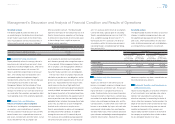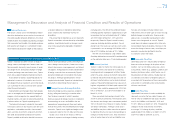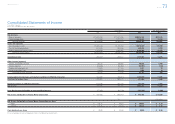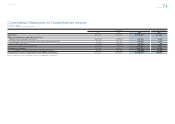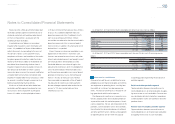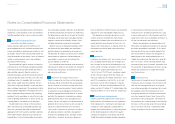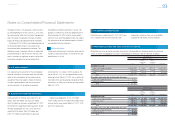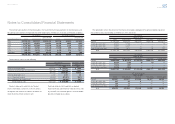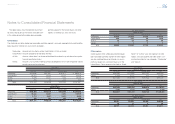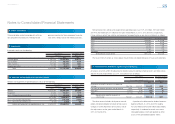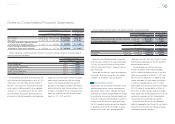Toyota 2013 Annual Report Download - page 80
Download and view the complete annual report
Please find page 80 of the 2013 Toyota annual report below. You can navigate through the pages in the report by either clicking on the pages listed below, or by using the keyword search tool below to find specific information within the annual report.
Toyota Global Vision President’s Message Launching a New Structure Special Feature Review of Operations
Consolidated Performance
Highlights
Management and
Corporate Information Investor InformationFinancial Section
Page 80
NextPrev
ContentsSearchPrint
ANNUAL REPORT 2013
Toyota classifi es wholesale and other dealer loan
receivables portfolio segment into three classes of
wholesale, real estate and working capital, based
on the risk characteristics associated with the
underlying fi nance receivables.
A receivable account balance is considered
impaired when, based on current information and
events, it is probable that Toyota will be unable to
collect all amounts due according to the terms of
the contract. Factors such as payment history,
compliance with terms and conditions of the under-
lying loan agreement and other subjective factors
related to the fi nancial stability of the borrower are
considered when determining whether a loan is
impaired. Impaired fi nance receivables include cer-
tain nonaccrual receivables for which a specifi c
reserve has been assessed. An account modifi ed as
a troubled debt restructuring is considered to be
impaired. A troubled debt restructuring occurs when
an account is modifi ed through a concession to a
borrower experiencing fi nancial diffi culty.
All classes of wholesale and other dealer loan
receivables portfolio segment are placed on non-
accrual status when full payment of principal or
interest is in doubt, or when principal or interest
As of March 31, 2012 and 2013, fi nance receivables on nonaccrual status were as follows:
Yen in millions U.S. dollars in millions
March 31, March 31,
2012 2013 2013
Retail ¥ 2,822 ¥ 4,443 $ 47
Finance leases 958 1,135 12
Wholesale 5,485 1,985 21
Real estate 11,736 4,354 46
Working capital 37 70 1
¥21,038 ¥11,987 $127
As of March 31, 2012 and 2013, fi nance receivables past due over 90 days and still accruing were as
follows:
Yen in millions U.S. dollars in millions
March 31, March 31,
2012 2013 2013
Retail ¥24,263 ¥18,442 $196
Finance leases 7,674 3,464 37
¥31,937 ¥21,906 $233
is 90 days or more contractually past due, whichev-
er occurs fi rst. Collateral dependent loans are
placed on nonaccrual status if collateral is insuffi -
cient to cover principal and interest. Interest
accrued but not collected at the date a receivable is
placed on nonaccrual status is reversed against
interest income. In addition, the amortization of net
deferred fees is suspended.
Interest income on nonaccrual receivables is rec-
ognized only to the extent it is received in cash.
Accounts are restored to accrual status only when
interest and principal payments are brought current
and future payments are reasonably assured.
Receivable balances are written-off against the
allowance for credit losses when it is probable that
a loss has been realized. Retail receivables class
and fi nance lease receivables class are not placed
generally on nonaccrual status when principal or
interest is 90 days or more past due. However,
these receivables are generally written-off against
the allowance for credit losses when payments
due are no longer expected to be received or the
account is 120 days contractually past due,
whichever occurs fi rst.
Notes to Consolidated Financial Statements
Allowance for credit losses
Allowance for credit losses is established to cover
probable losses on fi
nance receivables and vehicles
and equipment on operating leases, resulting from
the inability of customers to make required pay-
ments. Provision for credit losses is included in sell-
ing, general and administrative expenses.
The allowance for credit losses is based on a sys-
tematic, ongoing review and evaluation performed
as part of the credit-risk evaluation process, histori-
cal loss experience, the size and composition of the
portfolios, current economic events and conditions,
the estimated fair value and adequacy of collateral
and other pertinent factors. Vehicles and equipment
on operating leases are not within the scope of
accounting guidance governing the disclosure of
portfolio segments.
Retail receivables portfolio segment
Toyota calculates allowance for credit losses to
cover probable losses on retail receivables by apply-
ing reserve rates to such receivables. Reserve rates
are calculated mainly by historical loss experience,
current economic events and conditions and other
pertinent factors.
Finance lease receivables portfolio segment
Toyota calculates allowance for credit losses to
cover probable losses on fi
nance lease receivables
by applying reserve rates to such receivables.
Selected Financial Summary (U.S. GAAP) Consolidated Segment Information Consolidated Quarterly Financial Summary Management’s Discussion and Analysis of Financial Condition and Results of Operations Consolidated Financial Statements Notes to Consolidated Financial Statements [3 of 44]
Management’s Annual Report on Internal Control over Financial Reporting Report of Independent Registered Public Accounting Firm


